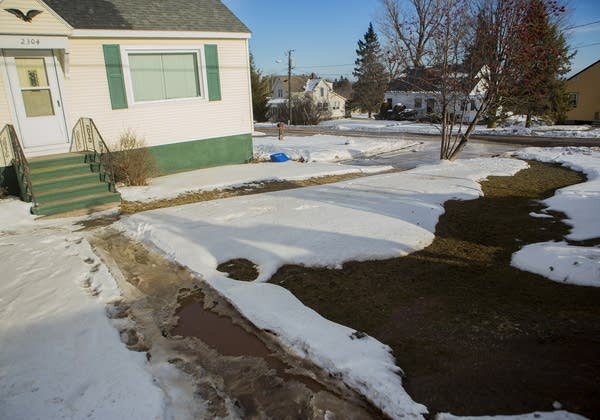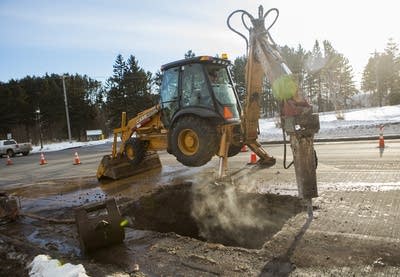$6 billion tab projected for Minnesota water line fixes
Go Deeper.
Create an account or log in to save stories.
Like this?
Thanks for liking this story! We have added it to a list of your favorite stories.

It's pretty easy to take drinking water for granted. Open the faucet and out it comes. But in recent days, major water main breaks in Minneapolis, Duluth and Sioux Falls, S.D. have highlighted the massive labyrinth of underground pipes that delivers water to homes and businesses.
In many Minnesota cities, that system is old and in need of replacement. That became clear on New Year's Day, when a water main buried 12 feet underground in downtown Duluth cracked and released three million gallons of water. The next day, Duluth Utilities Operations Supervisor Dan Berg stood next to the 35-foot wide crater left behind when water gushed out of the broken pipe.
"When you blow a three-foot hole in it, it's powerful enough to crack that concrete," Berg said. This whole area was lifted up about a foot and a half before it finally broke through the surface and headed down to Lake Avenue."
Berg estimates it cost the city about $35,000 to repair the street and the ruptured pipe, which hasn't been replaced since it was installed 125 years ago in 1887.
Turn Up Your Support
MPR News helps you turn down the noise and build shared understanding. Turn up your support for this public resource and keep trusted journalism accessible to all.
The city spends about $2.3 million every year to fix breaks and smaller leaks in the city's aging water system, Duluth Mayor Don Ness said.
"We spend a tremendous amount of resources in digging up the street, fixing the leak, and then covering it back up," Ness said, "making no permanent repairs to that waterline, but expending a tremendous amount of money."

In Duluth, 426 miles of pipe crisscross the city underground. About half of the pipes are more than 80 years old. Over the past decade the number of water main breaks has doubled to about 140 every year.
Ness said the city needs to start replacing pipes, not just patching them. But historically that's been a tough sell.
"From a political standpoint, there's no upside to investing in underground infrastructure," he said "People take it for granted, and they don't think about it until it's not working."
But the city has now adopted a plan to slowly replace its aging system of water pipes. It has increased water rates for a typical home by 30 percent in the past year, or nearly $5 more a month. City engineer Eric Shaffer said the goal is to replace four miles of pipe a year, at a cost of roughly a $100 a foot.

"That would get us replacing every single pipe at least once every 100 years," Shaffer said. "Right now four miles is probably really not enough because we're behind the eight ball, but we have to start somewhere."
The broken Minneapolis pipe that released an estimated 14 million gallons last week was installed in 1890. It burst during construction of a big apartment and retail complex. But it was in excellent condition, and a half-inch thicker than newer pipe, said Marie Asgian, Minneapolis Superintendent of Water Distribution.
Still, across Minnesota, cities are struggling to maintain their current infrastructure while trying to come up with the money needed to replace it. The costs are staggering. A 2007 federal study estimated Minnesota's drinking water system needs $6 billion in repairs and upgrades. That doesn't even include the fixes sewer systems need, which state officials estimate at another $4.5 billion.
"It all comes down to funding and how much people are willing to pay for the water that they receive," said Steve Schneider, general manager of St. Paul's Regional Water Services, which serves the Capitol city and several suburbs.
Like Duluth, St. Paul's goal is a 100-year replacement cycle. With about 1,200 miles of pipe, that means replacing about 12 miles a year. To accomplish that, St. Paul has doubled its funding for water line replacement to about $5 million a year. Residents are paying the $5 million yearly tab through rate increases, said Schneider, also incoming chair of the Minnesota section of the American Water Works Association.
"It's built into our rate structure, funded by revenues we take in every year, we're not borrowing money to do it," he said.
A recent study from the American Water Works Association predicts water rates in some communities could triple within the next 25 years to pay for infrastructure upgrades. Small towns will be especially hard hit, said Nancy Straw, CEO of West Central Initiative, a community foundation in west central Minnesota.
"Because they don't have enough households to spread the bill out over time to pay it back before it fails. So it becomes an even more serious problem in communities that are smaller, say 600 or so in population."
There are grants and low-interest loans available. But that only covers a fraction of the need. A 2013 state Department of Health priority list includes 340 projects at costs totaling about $385 million.
State health officials have identified nearly $400 million in high-priority water projects in Minnesota. But every year there is typically only about one-tenth of that amount available in state and federal funding.
— Follow Dan Kraker on Twitter: http://twitter.com/dankraker





